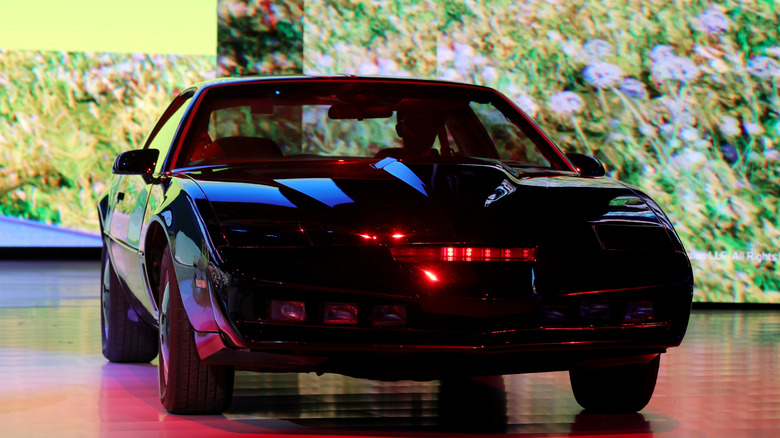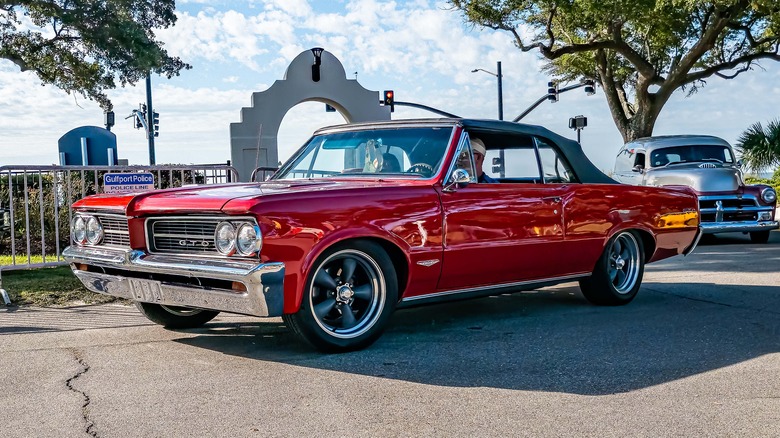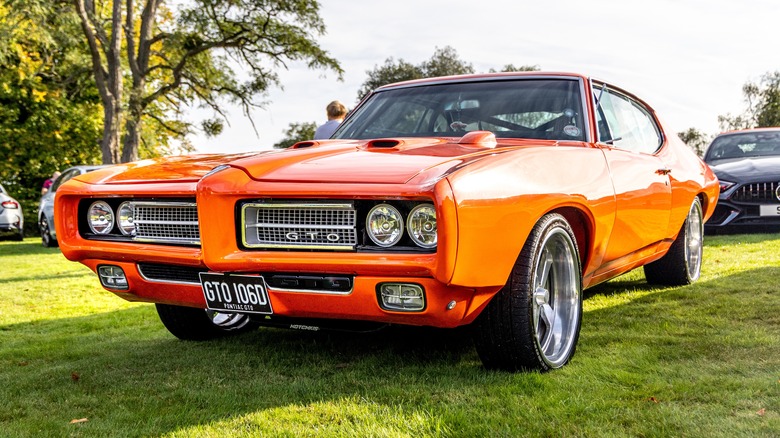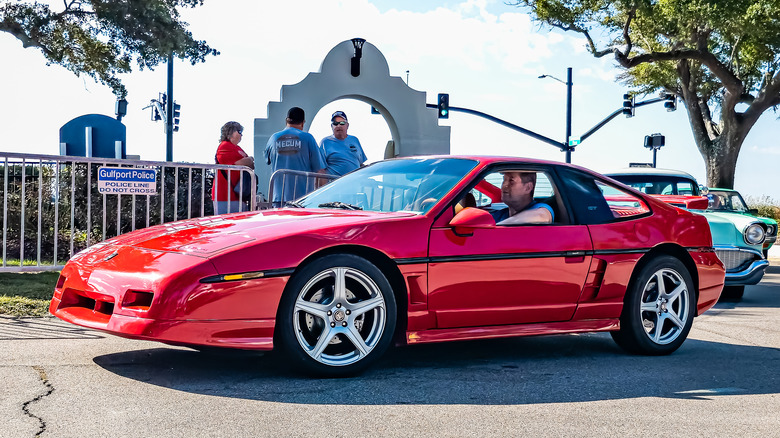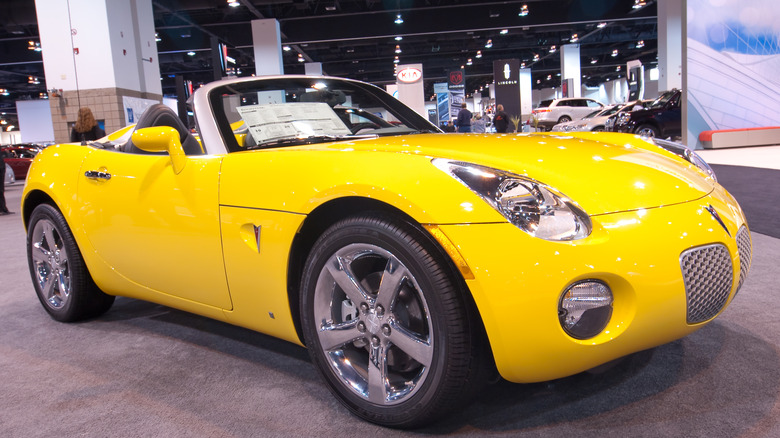5 Of The Most Iconic Pontiac Sports Cars Ever Made
In the 1980s, Pontiac adopted the tagline "We Build Excitement." By that point, the auto brand had been around for over 50 years and produced a number of cars that certainly lived up to the advertisement. Many of Pontiac's models were not only exciting, but also truly instrumental in shaping the culture of the American sports car.
The Pontiac GTO is widely cited as the model that introduced the masses to the American muscle car, popularizing a new kind of sports car that made serious performance affordable. The third-generation Pontiac Trans Am represented a revival of the pony car in the 1980s after a decade of underpowered and emissions-choked disappointments, becoming a widely recognized model after its starring appearance in "Knight Rider." The Pontiac Fiero rewrote what an American car could be, placing an engine behind the driver in a mid-mounted layout — a formula typically reserved for Europeans at the time.
While Pontiac might have closed its doors for good in 2010, some of the company's sports cars will be remembered for generations to come. Instead of "We Build Excitement," a more apt slogan might have been "We Build Icons."
The 1964 Pontiac GTO is legendary
While the origins of the American muscle car can be traced back to the late 1940s with the big-engined, lightweight Oldsmobile Rocket 88, most people consider the beginning of America's golden era of muscle cars to be 20 years after the Rocket hit the streets. That golden era was unknowingly kicked off in 1963 when Pontiac's chief engineer John DeLorean (yes, that one) decided to ignore parent company GM's ban on racing-capable cars. During a brainstorming session, Bill Collins, another Pontiac engineer, suggested to DeLorean that they put a high-performance four-barrel 389-cid V8 under the hood of the new-for-the-time intermediate-size Pontiac Tempest. Exploiting a loophole in GM's racing ban by making the 389 V8 an optional engine instead of the base one, America's first golden-era muscle car was born.
Almost immediately, the 1964 Pontiac GTO was a major success. In the first year, it sold over six times its predicted sales volume with 32,450 units built. By 1967, Pontiac had sold over 286,000 GTOs to eager Americans of all backgrounds. The car's massive sales success couldn't be ignored by the rest of the United States' top manufacturers, spurring Ford, Plymouth, and Dodge to try to capture some of the GTO's magic for themselves. In the years to come, cars like the Dodge Charger and Plymouth Barracuda Hemi competed with the GTO for muscle car supremacy. Thanks in large part to the GTO, the muscle car became America's major contribution to the wider sports car market.
The 1969 Pontiac GTO Judge was an even bigger beast
Five years after the introduction of the first-generation Pontiac GTO, the model's sales began to dip as a result of the market being flooded with new competition. The GTO received a full-body makeover for the 1968 model year, introducing the second generation's iconic split grille Endura front end, more aerodynamic body styling, and new high-displacement engine options. While the standard GTO was a well-equipped car already, the second generation's most iconic model arrived on the scene a year after the facelift. The special edition model was known as "The Judge" and represented the highest-performance GTO model that Pontiac had made up to that point.
The Judge was built to compete with the stiffest competition available in the late 1960s, targeting the Plymouth Road Runner specifically. The Judge's name came from a comedy sketch from Rowan and Martin's then-popular television show "Laugh-In," which spoke to how Pontiac marketed the model. It was meant to be almost comically attention-seeking and a somewhat cartoonish commentary on the American muscle car scene of the 1960s, featuring a flamboyant paint job, psychedelic badging, and a big rear wing.
The Judge certainly accomplished that goal, not only through its looks but also through its performance. It came equipped with two of Pontiac's most ludicrous high-output engine options, the 366-horsepower Ram Air III and 370-horsepower Ram Air IV V8s, making The Judge one of the best-performing muscle cars for the money. While GTO sales began declining in 1969, The Judge's vibrant personality and dominant performance made a lasting impression on the American sports car scene.
The 1982 Pontiac Trans Am defined the '80s
The 1980s were a transitional time for American sports cars. In the decade prior, almost every American performance car was neutered by a combination of factors. The country was becoming more environmentally conscious, with the 1970 Clean Air Act imposing strict new emissions regulations that significantly diluted the performance of high-output V8 engines. Combine that with rising insurance rates and the 1973 oil crisis, and American sports cars devolved into shadows of their former selves. The Pontiac Firebird Trans Am, one of the coolest American pony cars ever built, was severely impacted by the "Malaise Era," with its second generation producing only 220 horsepower in a sluggish package at the end of its run in 1981.
However, Pontiac had a trick up its sleeve for the third-generation Trans Am released in 1982. Instead of focusing purely on power, which was also improved later in its build cycle, the new Trans Am emphasized aerodynamics, chassis dynamics, and a smaller form factor. Its quintessentially 1980s body was sculpted using a wind tunnel, making it the most aerodynamic model in the entire GM fleet at the time. It was also 11 inches shorter and 400 pounds lighter than the previous generation, which gave it great handling compared to both its previous model and most models of the time.
By the late 1980s, the third-generation Trans Am's improved chassis dynamics were combined with increased horsepower numbers, a serious return to form compared to the models of the 1970s. The 1982 Trans Am represented a major turning point for American sports cars, proving that performance could come from other advancements outside of raw power.
The 1985 Pontiac Fiero GT was ahead of its time
As exemplified by the third-generation Trans Am, the 1980s were a time of experimentation for both Pontiac and the larger American auto industry. Cars like the turbocharged Buick Grand National and Ford Taurus SHO were experimental new entries to get young people interested in performance driving, and Pontiac approached that concept in 1984 with a revolutionary and unorthodox approach to capturing that market.
Pontiac's desire to create a small, two-seat sports car arose in the early 1960s but was sidelined due to GM's distaste for any cars that would compete with the Chevrolet Corvette. However, the idea crept back up in the late 1970s with a different spin. Instead of pitching the new two-seater as a sports car, the Pontiac strategic planning committee led by Denny O'Donnell argued for a small, mid-engined commuter car that would meet strict emissions requirements while delivering an enjoyable driving experience. That car would go on to become the Pontiac Fiero, which eventually morphed from an innovative commuter to a fully-fledged sports car.
Prior to the Fiero, there had never been a mass-produced mid-engined American car. While the Fiero was initially introduced with the maligned "Iron Duke" inline-four, its mid-engine layout, in theory, provided better weight distribution and handling characteristics than most front-engine cars. The Fiero GT was introduced in 1985 and transformed the platform into a proper sports car, featuring upgraded suspension and a 140-horsepower 2.8-liter V6. Ultimately, the Fiero was a commercial failure that was discontinued after only four years in production. While it was a flop by most metrics, its innovative design challenged the predominant definition of the American sports car, making it a household name.
The 2007 Pontiac Solstice GXP was a proud last hurrah
In many ways, the Pontiac Solstice was a spiritual successor to the Fiero, though it came 25 years later. The small, two-seat, affordable Solstice started life as a concept car, first appearing at the 2002 North American International Auto Show in Detroit. It was greenlit by Pontiac's vice chairman of product development, Bob Lutz, as a $20,000 competitor to the likes of the wildly successful Mazda Miata. To keep costs to a minimum, the Solstice was a true parts bin special, borrowing many components from other GM models, just like the Fiero. While the Solstice was pitched as an innovative passion project for Pontiac, it was actually a last-ditch effort to keep the doors open.
Unlike the Fiero, the Solstice was actually a very capable and successful car. The initial Solstice was praised almost universally for its communicative steering, stiff chassis, and satisfying handling characteristics. Its Mazda-beating performance helped its sales figures too, with Pontiac selling 21,000 units in 2006. Things kept improving when the GXP trim level was introduced in 2007. The new model received a 2.0-liter Ecotec turbocharged inline-four that put out a very respectable 260 horsepower and 260 lb-ft of torque, making it competitive against the BMW Z4 and Nissan 350Z.
Despite the celebrated performance and promising sales of the Solstice, GM declared bankruptcy in light of the 2008 recession, leading to Pontiac's demise. While Pontiac wouldn't survive into the 2010s, the Solstice represented a valiant last hurrah for the brand.
